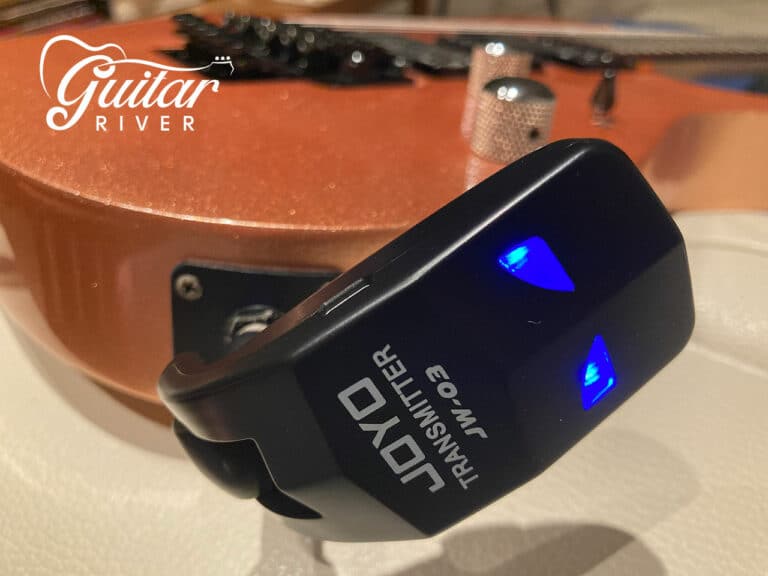Guitar River is reader-supported. We may earn a commission when you make a purchase using the links on our site.
Learn more.
How To Go Wireless With An Electric Guitar

As I look at the mess of coiled guitar cables on my floor, it makes me wonder, can an electric guitar be wireless? It is after all a piece of electronic equipment. A guitar cable seems pretty rudimentary. Surely we can improve on that connection, right? I mean, you can buy a refrigerator with Bluetooth!
The short answer is yes, an electric guitar can be wireless. This requires an electric guitar wireless system, which can be purchased at a starting price of under $100. The wireless system is made up of a transmitter connected to the guitar, and a receiver connected to the amplifier or sound system. Guitar wireless systems can be digital or analogue, and vary in transmission range, frequency, battery life, and other features.
Setting up a wireless connection between your electric guitar and amplifier is a great way to streamline your playing experience. As with anything guitar-related, you will find a variety of options and opinions about wireless systems. In this article, we will try and supply you with a little bit of knowledge to help you find the right wireless system.
Ditch the Cable and Go Wireless
For the purpose of this article, we will assume that you’ve had enough of guitar cables. Whether performing on stage, or just playing for fun in your living room, becoming entangled with your electric guitar cable is a frequent occurrence. And to make matters worse, your guitar cables have not lasted. It’s time to go wireless!
Wireless systems are relatively straightforward, but there are a few things to keep in mind before you make your purchase. The first step is to understand the different types of systems on the market.
Once you know the type of system you want, it will be helpful to decide on a budget, and compare the primary features including battery life, the wireless frequency, and system range.
Step 1, Choose Your Type of Wireless System
Guitar wireless systems fall into two different categories–analogue and digital. While they both work well, players will prefer one over the other based on the performance venue where the system will be used, the technical characteristics of each type of system, and cost considerations.
Analogue
Analogue wireless systems are straightforward and reliable. The audio is transmitted over a wireless frequency band. The musician’s electric guitar is plugged into a wearable beltpack transmitter, and a wireless receiver picks up the signal.
One consideration with analogue systems is they can be subject to interference from other devices transmitting on the same frequency. This can make the initial setup and frequency selection a chore.
However, the technology has improved, and systems such as the Shure BLX14 series will automatically scan for the best frequency.
Analogue systems are subject to limitations in range. As the transmitter gets further away from the receiver, the signal gets weaker. This can lead to background noise, noticeable especially during quiet parts of a performance. A weak signal can also contribute to signal dropout.
Digital
Digital wireless systems aim to solve some of the problems associated with analogue systems. Generally, they offer a longer range and more resistance to signal interference.
With the longer range comes less background noise and potentially better sound quality. A digital system is well-suited for musicians playing in larger venues because of the increased range.
Some digital systems cut out the need for a bodypack transmitter and cable running from the transmitter to the guitar. Instead, the transmitter plugs directly into the guitar’s output jack.
In addition, most digital transmitters feature rechargeable Lithium-ion batteries instead of standard alkaline batteries. This gives you longer battery life, and can avoid a signal dropout due to dead batteries.
Surprisingly, digital systems can be affordable. The Xvive Audio U2 system starts around $150. The Xvive system specs note that it’s not compatible with active pickups. So double-check the manufacturer’s specifications for compatibility with your guitar before you buy.
Now that we know about the two types of wireless guitar systems, the next step is to choose your budget, and compare the features.
Step 2, Know Your Budget and Compare Wireless Features
Affordable vs. Professional Systems
There are basically two price ranges for guitar wireless systems. We will classify under $200 as affordable, and professional systems that cost hundreds, or even thousands of dollars. You will find wireless systems on sale at Amazon.com under $40! That’s competitive with the price of a guitar cable.
Frequency
Affordable systems operate on common wireless frequencies–2.4 GHz and 5.8 GHz. Your home wi-fi, cordless phones, baby monitors, and other household wireless devices transmit on these frequencies. The 2.4 GHz frequency band has been around longer and may be more crowded than 5.8 GHz, but will have a longer range.
Professional systems operate on different frequency bands altogether. Some run on the 600 MHz and 700 MHz bands, although these systems are being phased out by the FCC. Refer to the FCC documentation for wireless microphones if you are curious.
Browsing Sweetwater.com, professional wireless systems operate in the H9 through H11 bands, and the J11 band. This lettering corresponds to a range roughly in the 500-600 MHz frequency band. A and G bands are also available. Basically, these systems are designed for stage use, and use different frequency bands than the less expensive systems to avoid interference.
Shure has a wireless frequency finder tool you can use to narrow in on the band appropriate for your area.
Range
When shopping for a wireless system, be sure to pay attention to the system’s range. Most systems start with around 50 or 100 feet of range, and go up to about 200 feet or line of sight. A longer range will make a difference to you if you are performing in a large venue.
Battery Life
Battery life of the devices can vary as well. Some wireless systems can last as much as 12 hours per charge, while others only last 5 hours. Depending on how long you want to use the system in one session, a longer battery life may be important to you.
Cost of Wireless vs. Cables
Electric guitar cables vary widely both in price and quality. You can buy a basic cable for $10, or splurge on a high-end cable and spend north of $200! Ultimately, the price is not always an indication of how long the cable will last.
Related: Check out our article on guitar cables if you want to know the difference between a budget and premium cable.
You may need to replace your cables every so often when they stop working due to malfunction or every day wear and tear. Since guitar cables are frequently on the ground, normal wear and tear can happen pretty easily.
With a wireless system on the other hand, there is less wear on the system itself. You still need to take care of it like any other piece of equipment. But it’s less likely to stop working due to a poor solder joint or because someone stepped on it–as in the case of a guitar cable. You just need to remember to keep it charged!
Even though the initial cost is greater, it may be worth it in the long run to switch to wireless.
How Much Do You Need to Spend on a Guitar Wireless System?
As you might expect, the cost range of a guitar wireless system is much bigger than electric guitar cables. Ruling out some of the cheap ones, a reasonable starting price for a wireless system is around $60. And the price can go as high as $1,200 or more on the higher-end.
How much you spend should be determined by your budget and your needs. For example, if you are buying a system for your band and about to go on a world tour, the $60 starter system may not meet your needs.
On the other hand, if you just want to try out a wireless system with your electric guitar and are just practicing, by all means, start with the $60 (or less) option.
Our recommendations are to stick with a name brand, and don’t buy more than you need. In the affordable range, $60-150 should buy you a decent system. And expect to pay around $300-600 for a high-quality name brand professional system.
Wireless Is Worth The Cost
By purchasing an electric guitar wireless system, you are making an investment. You pay more up front, but wireless systems can last longer than standard guitar cables.
Along with the longevity of the system comes a few additional benefits. Primarily, you now have the freedom to move around with your guitar without being encumbered by cables. This may be less of an issue playing at home, but when performing on stage, or practicing with your band, you will enjoy the elimination of the guitar cable.
And if you appreciate minimalism, you can now get rid of that coiled pile of cable you typically have to store somewhere in your practice area. One less thing on the floor to trip on.



